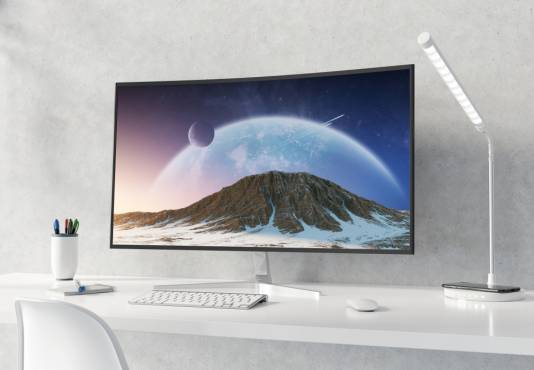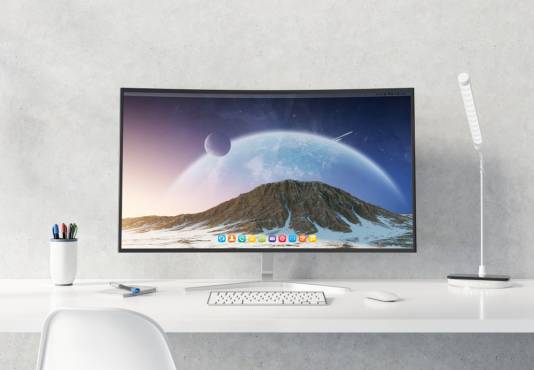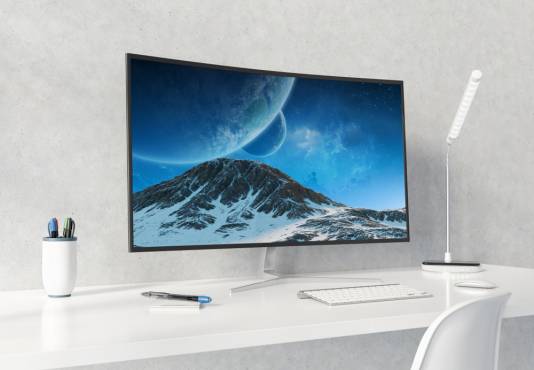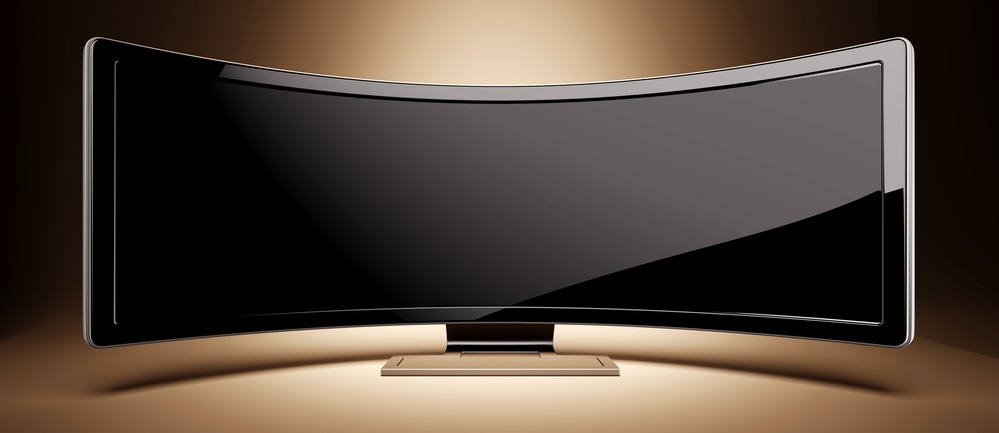You may remember when curved PC monitors were first launched on to the consumer market in 2014 because they seemed really futuristic. Many people thought they would be a passing fad, but several years later they are still around and are more popular than ever. And for very good reason.

What are curved PC monitors?
It may be stating the obvious, and you could probably guess, that curved monitors are slightly curved which means that they are more compatible with your field of view. Whether you’re working from home or in the office, this creates a much more realistic viewing experience. However, to fully notice the benefits of a curved monitor, you’ll need one which is at least 30 inches or more. The general rule is that the best curved monitors are the widest ones, as they also provide plenty of room for multiple windows and apps to be on display simultaneously. However, there are lots of things to take into account when choosing a curved monitor.
If you’re used to looking at a flat computer monitor, we think you’ll appreciate how a large curved monitor simulates the feeling of looking outward at what feels like a naturally fuller image. We believe that once you’ve experienced the depth and immersive viewing experience that you’ll find it difficult going back to a traditional flat screen monitor.
Some people don’t care for the curved style and others believe that the possible extra price to switch from a flat screen isn’t worth paying. We’re going to take a detailed look at the pros and cons of buying a curved monitor, but the decision really comes down to your own personal preference combined with the amount of money you’re prepared to spend on your computer setup.
There are plenty of benefits to purchasing a curved monitor, but there are also downsides too. Before you go ahead and take the plunge with your hard-earned money, have a read of all the pros and cons we’ve put together. Hopefully we’ll help you come to the decision which is right for you. Let’s take a look at some of the key considerations.
The curve of the PC monitor
Is biggest always best? Well, the size is definitely important for you to get the most out of a curved monitor, but one of the most important specs to keep in mind when comparing monitors is actually the radius of the curve. The curvature of these monitors is signified with an ‘R’, or radius, which is always measured in millimetres.
Every curved monitor will have one of three common measurements: 1800R, 3000R, or 4000R. All you have to remember is that a lower number means a bigger curve. There are more measurements than those above, but you’ll find all the other radius measurements are between those three numbers.
Viewing angle
A bigger curve provides a wider viewing angle. When viewing a standard flat LCD screen from any angle other than head on, the viewer will often lose out on contrast and colour saturation due to the way the way the light is projected from the screen. The slight bend in a curved screen actually compensates for the normal distortion giving you a wider viewing angle than your standard flat LCD.
So, what we’re saying is that curved PC monitors work best when you sit directly in the centre of the screen. If you sit off-centre then you will likely see a distortion of images. You’ll either need to be happy using one large curved screen or you’ll need to purchase a larger desk to accommodate multiple curved screen.
Shop for monitors at Ebuyer : Over 700 to choose from
Curved monitor resolution
Although playing your favourite video games on a dazzling 4K curved monitor is ideal, you’ll save money if you buy a model sporting the Full HD standard (1080p). With that said, a curved monitor that features a higher resolution displays a wider range of colours, deeper black tones, and a more true-to-life image. Remember, Full HD is the bare minimum resolution that you should buy, and if you’re already opting for a curved monitor, then it’s definitely worth spending your money a model with an even sharper picture.
A curved PC monitor creates depth
Due to the way they bend, curved monitors tend to have less of a glare and they minimize reflections which can be really annoying and detract from your viewing experience.
Of course, it’s still possible to place your monitor in such a way that you get a blinding glare. Some common sense is required as to where you place your new monitor, and once it’s in the right spot, you’ll have less to worry about than you would with a flat screen.
Fans of curved screens will tell you that they have a more organic feel and they mimic your field of view by allowing your peripherals to catch glimpses of the display. It’s a much more natural way of viewing things. This makes gaming feel much more realistic, and so brings more depth to images on screen.
Basically, due to the nature of the screen curved PC monitors deliver an almost 3D-like picture without the annoyances and headaches of actual 3D viewing. Obviously, the images you see on a curved screen are not 3D, the curvature of the screen enhances your perception of depth. It may be quite subtle, but when you compare it against a flat screen, it does make a difference.

Monitor size
When it comes to curved PC monitors, a larger size does give you a superior experience, and here’s why: If you get a curved monitor which is under 30 inches and compare that to the average flat LCD monitor, you’ll actually notice little difference. That being said, 30 inches (and above), is larger than many people actually want, and larger monitors of course, come with a cost.
Anyone who’s had an opportunity to play their favourite games or multitask on a larger, curved monitor appreciates the engaging, riveting viewing experience provided by the larger screen. If you’re thinking about buying a curved monitor to enhance your gaming or work output, then you will get a superior viewing experience if you go for something on the larger side.
Is distortion an issue?
You’ve probably never noticed, but some people believe there are slight geometric distortions with a curved screen. Most notably, there can be a ‘bow tie’ effect where the edges are marginally stretched compared to the centre. This one is a bit contentious as many people simply don’t notice any distortion from standard viewing angles. It’s only when you’re viewing from off-centre that the issue comes into play.
Viewing Angle
This one is all about the angles. Although they technically present a wider viewing angle for distortion, curved screens also naturally restrict your viewing range. Most manufacturers believe this to be around the 35-degree mark, where the corners of the image become distorted simply due to the curve in the screen.
The gaming experience
As we’ve mentioned already, curved screens attempt to make you feel more immersed in what you’re watching, therefore theoretically enhancing the enjoyment.
This immersion is particularly effective for gamers, as anyone sitting in the curved screen sweet spot gets a real sense of immersion in their game. You can also expect razor-sharp images and outstanding colour balance as you take on your next opponent.
Curved monitors look great
Yes, we know that this is subjective, but you have to admit that curved screens just look better than their regular counterparts. In the same way that LCDs were an advancement on CRT, curved screens just look futuristic. Looks are important when it comes to anything which sits in your house – as it is also a piece of furniture.
Can you wall-mount a curved monitor?
As you can imagine, mounting a curved monitor to a wall won’t look as good as a mounted flat monitor, since the screen isn’t flush with the wall. Some people do position them on the wall and manufacturers do offer wall mounts for curved screens. However, after the strikingly cool look of a curved TV positioned on a unit, a hanging curved screen looks little bit out of place. it’s purely a personal choice.
The cost
Curved-angle screens tend to be more expensive than flat screens in general. As with all monitors though, the price will vary depending on resolution, screen size, features, and the number and type of ports it offers.
Who will benefit most from a curved monitor?
Since curved monitors tend to be a lot more expensive than flat monitors, you’ll want to consider if the amount of time you use your computer warrants the cost. Serious gamers and those who spend long hours on their computer, such as graphic designers and photographers, would benefit the most from using one. Since these displays tend to be larger, they’re also a great fit for anyone who works in multiple programs and windows at once.
Shop for monitors at Ebuyer : Over 700 to choose from
Here’s a quick round-up of the pros and cons of curved monitors
Pros:
- Fewer reflections to make viewing more pleasurable
- Wider field of view to enhance the experience
- More immersive gaming – be a part of the action
- Curved monitors look ultra-cool
Cons:
- Curved monitors tend to be more expensive
- They are not ideal for wall mounting
- To have the best viewing experience you need to view from the direct centre of the display
- Works best if it’s the only monitor
- The larger the monitor, the more effective it is
- Some people notice slight screen distortions
- You may need more space

FAQ
Q. Is a curved monitor a good fit for multiple viewers at once?
A. No, not really. The person who sits directly in front or slightly off-centre will have the best viewing experience. The farther away from the centre a person is, the image may not be perfect. You also have to bear in mind that if you watch a curved monitor at an uncomfortable angle for long periods of time, it may result in eyestrain
Q. Do I need to buy a curved monitor that is also “ultra-wide?”
A. No, but the wider the monitor, the better, as it delivers additional depth, immersion and more details. Monitors with smaller aspect ratios cannot provide this. Remember that a curved monitor already gives you a larger aspect ratio than the average monitor, but an ultra-wide curved screen will make your viewing experience unforgettable.
Q. Are curved monitors more expensive than traditional flat models?
A. The answer is yes. This is always the case with newer technology, but prices are gradually coming down and will continue to do so.
Q Is gaming better on a curved screen?
A. Yes, and it’s due to that word – immersion. Just like a curved screen offers the best movie watching experience, streaming and gaming just feel much better – especially on your eyes. Because the images are kept equidistant from your eyes, it’s a much more natural experience. A curved monitor almost wraps itself around your field of vision.



